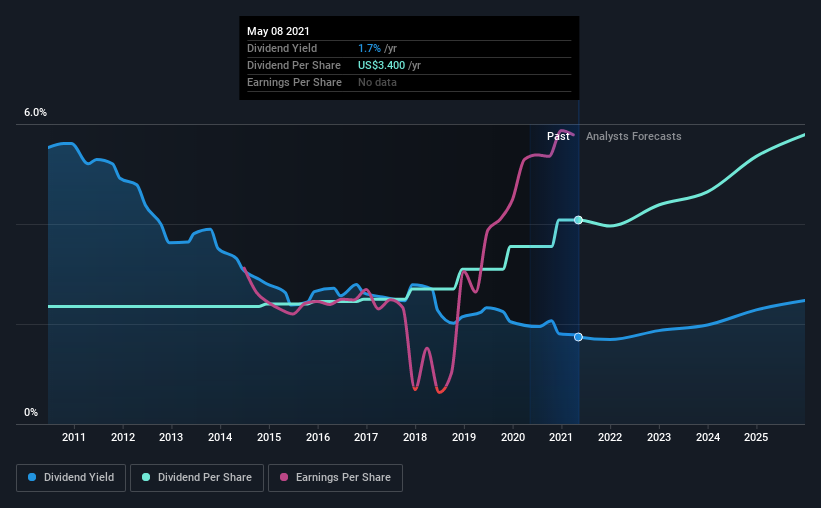Should You Buy Eli Lilly and Company (NYSE:LLY) For Its Upcoming Dividend?
Eli Lilly and Company (NYSE:LLY) stock is about to trade ex-dividend in three days. Ex-dividend means that investors that purchase the stock on or after the 13th of May will not receive this dividend, which will be paid on the 10th of June.
Eli Lilly's upcoming dividend is US$0.85 a share, following on from the last 12 months, when the company distributed a total of US$3.40 per share to shareholders. Last year's total dividend payments show that Eli Lilly has a trailing yield of 1.7% on the current share price of $195.42. If you buy this business for its dividend, you should have an idea of whether Eli Lilly's dividend is reliable and sustainable. That's why we should always check whether the dividend payments appear sustainable, and if the company is growing.
View our latest analysis for Eli Lilly
Dividends are typically paid from company earnings. If a company pays more in dividends than it earned in profit, then the dividend could be unsustainable. Eli Lilly paid out a comfortable 46% of its profit last year. Yet cash flows are even more important than profits for assessing a dividend, so we need to see if the company generated enough cash to pay its distribution. Dividends consumed 50% of the company's free cash flow last year, which is within a normal range for most dividend-paying organisations.
It's encouraging to see that the dividend is covered by both profit and cash flow. This generally suggests the dividend is sustainable, as long as earnings don't drop precipitously.
Click here to see the company's payout ratio, plus analyst estimates of its future dividends.
Have Earnings And Dividends Been Growing?
Stocks in companies that generate sustainable earnings growth often make the best dividend prospects, as it is easier to lift the dividend when earnings are rising. If earnings fall far enough, the company could be forced to cut its dividend. That's why it's comforting to see Eli Lilly's earnings have been skyrocketing, up 24% per annum for the past five years.
The main way most investors will assess a company's dividend prospects is by checking the historical rate of dividend growth. Eli Lilly has delivered 5.7% dividend growth per year on average over the past 10 years. It's good to see both earnings and the dividend have improved - although the former has been rising much quicker than the latter, possibly due to the company reinvesting more of its profits in growth.
The Bottom Line
Should investors buy Eli Lilly for the upcoming dividend? From a dividend perspective, we're encouraged to see that earnings per share have been growing, the company is paying out less than half of its earnings, and a bit over half its free cash flow. There's a lot to like about Eli Lilly, and we would prioritise taking a closer look at it.
So while Eli Lilly looks good from a dividend perspective, it's always worthwhile being up to date with the risks involved in this stock. To help with this, we've discovered 2 warning signs for Eli Lilly that you should be aware of before investing in their shares.
If you're in the market for dividend stocks, we recommend checking our list of top dividend stocks with a greater than 2% yield and an upcoming dividend.
This article by Simply Wall St is general in nature. It does not constitute a recommendation to buy or sell any stock, and does not take account of your objectives, or your financial situation. We aim to bring you long-term focused analysis driven by fundamental data. Note that our analysis may not factor in the latest price-sensitive company announcements or qualitative material. Simply Wall St has no position in any stocks mentioned.
Have feedback on this article? Concerned about the content? Get in touch with us directly. Alternatively, email editorial-team (at) simplywallst.com.

 Yahoo Finance
Yahoo Finance 
